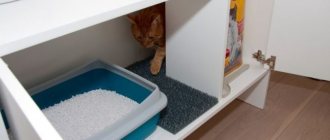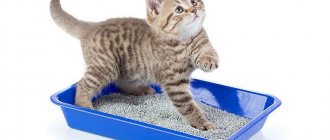The suffering of people whose cat began to shit in the wrong place is immeasurable. Most often in such a situation, the owner's bed and shoes, the threshold of the front door, the corners of rooms and the space under the bathroom suffer. You want to solve the problem as soon as possible, but in a hurry you can only make it worse: by not following the rules, it is easy to reinforce the animal’s erroneous behavior. We will tell you how to stop a cat from going to the toilet in the wrong place.
Why did the cat start shitting in the room?
The first thing you need to understand is why the cat began to upset its owners:
- This may be due to diseases of the gastrointestinal tract or genitourinary system.
- It is possible that the animal attracts attention in this way, showing that it needs help.
- Sometimes a cat’s toilet begins to be associated with pain. In this case, any attempts to return it to the tray will remain in vain until it is completely cured.
Important! If a cat experiences pain, pain or simply unpleasant sensations, if it cannot restrain involuntary urination, then educational measures are useless. In this case, urgent assistance from a veterinarian is necessary: a timely diagnosis and proper treatment will help solve the problem.
Main reasons not related to health:
- a significant change in the situation (moving, renovation, buying new furniture);
- non-acceptance of the premises where the toilet is installed;
- aversion to the smell of the material from which the tray is made (or its shape);
- antipathy to the filler (or its rare replacement);
- conflict between cats living together;
- lack of attention from the owners.
Sometimes an animal takes revenge for an insult in this way or protests if it doesn’t like something. This is his way of “explaining” to the owners: something is not as the cat wants. But there is no need to look for human logic and conscious behavior in such actions: everything is spontaneous, situational and subordinate to instincts.
Our article – rating of trays for cats – can help you with choosing the right accessory.
The reason can be elementary:
- the toilet was moved (turned);
- another cat went into the litter box;
- there is not enough food in the feeder and not enough water in the drinking bowl;
- The family pet is old, and these are age-related problems.
Sometimes a cat stops going because something startled her during a previous trip to the toilet: for example, someone suddenly walked by while the cat was doing her business.
A separate block is the natural need to mark the territory, protecting it from the encroachments of other animals or even guests who come to the house. And also in an effort to attract sexual partners. This is a powerful animal instinct, which cannot be overcome by educational measures.
Associated symptoms
Constipation does not necessarily mean a complete absence of bowel movements. Some cats have regular bowel movements, but very little feces come out. For this reason, the animal owner may not even be aware of the problem. It is important to find out in time that the cat has stool retention, before his condition worsens.
To understand that your pet needs help, you need to study the symptoms of constipation in a cat:
- the cat does not walk much for 48 hours;
- on palpation, the abdomen is enlarged and painful;
- the cat becomes restless and loses its appetite;
- the pet spends a lot of time in the tray, unsuccessfully trying to poop;
- the cat strains and meows pitifully;
- if the pet still manages to pass a large stool, then very little feces are excreted, it is dry and covered with cracks;
- there is blood in the cat's feces;
- the anus is hyperemic.
Attention! If a cat doesn't poop for more than 4-5 days, it's very bad. With prolonged constipation, signs of intoxication appear - lethargy, vomiting, and sometimes the temperature rises.
How to prevent cat misbehavior
You can never be sure of anything with a pet: it is a living creature that may have its own problems and its own views on how its living environment should be arranged. In order to protect your home as much as possible from surprises, the conditions for keeping the animal are thought out even before the mustachioed friend is brought into the house.
The cat loves cleanliness, order and clear organization of space. It would be wise to position the toilet in a way that she likes. Then she will agree to do her business where it is convenient for the owner.
Misbehavior in a cat can be prevented if:
- choose a toilet that your pet will like (even if you have to change several in a row);
- When purchasing a tray, take into account the size of the animal;
- place the tray in a secluded corner with 24-hour access to the room;
- place the feeding area away from the toilet;
- Do not place anything with a strong smell next door.
It is extremely important to clean your cat's litter box frequently:
- every time you change the filler;
- as soon as the smell appears;
- Trays used without filler are washed after each cat’s visit to the toilet.
The litter you choose is the one that suits your cat. We talked about the choice of filler taking into account the individual characteristics of the pet’s breed and age in this article. They change it without waiting for a strong smell to appear, which is individual for each animal.
Sometimes a cat shits in the room because of helminths: the pain and itching force her to look for a place where she can wipe off the remnants of the discharge. Often she looks for something soft - a carpet, a bed or a sofa. To prevent this from happening, even a healthy cat needs to be given anti-worm medication from time to time.
If your cat has urinary incontinence caused by illness or old age, you can only protect your floors and carpets by buying her diapers. This decision will be the only correct one; it will completely eliminate hassle and dirt in the house.
What information should cat owners provide to the treating veterinarian?
When contacting a veterinarian, it is important to provide the following information in more detail:
- Cat's age and lifestyle.
- When was constipation discovered and how did it manifest itself?
- Has the cat ever vomited, its frequency and frequency, and the type of vomit.
- List of food fed in the last 24 hours.
- Changes in behavior, urination, defecation, appetite, thirst.
During a clinical examination of a sick cat, the veterinarian can determine the presence of foreign bodies in the intestines, the presence of inflammation of the perineum and anus, problems with the anal glands, injuries to the pelvic bones and spine.
To more accurately determine why a cat is constipated, the following may additionally be prescribed in a veterinary clinic:
- general blood analysis;
- stool analysis for oviworms;
- abdominal x-ray;
- X-ray of the intestine with contrast to assess its patency;
- Ultrasound of the abdominal cavity.
Methods to Avoid
Measures for raising an animal must be completely safe for its health.
Absolute taboo:
- beating;
- poking your nose into a puddle or pile;
- dousing with water;
- rough pushing towards the tray;
- shout.
All this will only frighten, provoke stress and ultimately have the opposite effect. The cat will become insecure and begin to look through all corners in search of something for which it will not be punished.
A little scolding is necessary, but only if the cat was caught “doing this.” Delayed punishment is pointless, because the cat will no longer understand what the owner’s aggression is connected with.
Sometimes it is advised to lock the cat in a cramped room with a litter tray: if it cannot find another place, it will begin to go there. But this method is also quite cruel. Such treatment can frighten, offend the animal and cause a persistent aversion to the toilet.
Cleaning
First of all, remove clumps from the litter box daily and clean it frequently and thoroughly. This means discarding the old litter, washing the empty box with mild dishwashing soap and warm water, rinsing with clean water, air drying, and refilling with fresh, unscented litter (sometimes scented material can be unappealing to picky cats).
Whenever you interact with the litter box, always use rubber gloves and a face mask to protect yourself from microscopic insects and dust.
Warning
If you are pregnant, delegate all litter box care to another family member to reduce the risk of contracting toxoplasmosis.
How to stop a cat from pooping all over your apartment: proven methods
It is not at all difficult to train a small kitten to use a litter tray. But if an adult cat suddenly changes its habits, or the animal is taken from the street, only those who show patience and love will achieve success.
The owner needs to show the cat that he is against him shitting anywhere and take care of cleanliness:
- the dirty floor is immediately washed and disinfected;
- it is possible to use an odor repellent;
- soiled shoes are thoroughly cleaned and put away.
Many cats urinate in one litter box and defecate in another. In this case, the problem can be solved in the easiest way: just place two containers next to each other.
If the cat is left alone for a long time, you will have to get another potty, because this animal will not go into a dirty tray.
Sometimes it is enough to change the brand of litter to the one the cat is used to. If there is a need to accustom the cat to a different litter, the change is made gradually, mixing the new brand with the old one in increasing proportions.
After making sure that the animal is healthy, you can apply educational measures:
- give a treat every time the cat goes into the litter box: to positively reinforce correct behavior;
- put a bowl of food where it is pooped: cats do not go to the toilet where they eat;
- in cases where “you can’t stock up on any bowls,” you can lay out dry food in areas that have been thoroughly washed of urine or feces beforehand.
If the cat gets into the habit of walking on any object that can be removed for a while (a rug, a chair), then it is better to take the thing out altogether or stop the cat’s access to the room. But it cannot be guaranteed that, having stopped shitting in the wrong place for some time, even for a long time, the cat will not eventually begin to use this thing as its toilet again.
A very effective way for a small kitten is to soak a cloth in his urine and put it in the tray. The smell will point the animal to the right place. The same can be done for an adult cat brought from the street.
A good method is to place the tray where the cat began to shit, gradually moving it to where the owner needs it. Often the cat obeys or does not notice the change in the position of the potty. But sometimes you have to come to terms and permanently move the tray to the corner chosen by the animal.
You can make a place favored by a cat inaccessible:
- cover with something that is better unpleasant for the paws;
- fence with a strip of double-sided tape;
- make inaccessible (fence, cover).
Sometimes it turns out to be effective to create a situation of discomfort at the moment when the cat settles down in the corner of its choice (unexpected appearance, clapping of hands). But the animal always understands that it is doing something bad, and tries to do it when no one is around. The owners will have to keep watch, and perhaps more than once.
To prevent a cat taken from the street from marking the entire apartment, you can collect its scent on a porous fabric (by rubbing it on the fur, for example) and spread its pieces around the apartment. Then the animal will understand that this is its territory, which does not need to be marked.
To prevent pets from spraying gonad secretions and urine around the apartment, males are castrated and females are sterilized. But if this is done late, when the behavior has already become entrenched, the operation will not get rid of the marks. Your veterinarian will help determine the correct age for this procedure.
An animal that shits in the wrong place in order to find a sexual partner can simply be given the opportunity to satisfy its instinct, and silence and cleanliness will return to the apartment.
There is one more absolute rule: a cat’s misdeed, committed in front of the owner, should never go uncondemned. Because the cat must clearly understand what is acceptable in its behavior and what is not.
Why is constipation dangerous?
Defecation is a natural process through which the intestines are freed from processed substances. If feces are retained and not released for several days, this leads to severe intoxication of the body.
When a cat is constipated, bacteria that live in the large intestine release toxins, and waste bile contains breakdown products of hemoglobin.
If a cat cannot go to the toilet for a long time, and this happens often, this is bad. This means the pet needs help. After all, systematic constipation can lead to intestinal obstruction and internal bleeding.
Protecting your home with special tools
The industry produces many products for correcting animal behavior. At the pet store you can choose them in the form of a spray, powder, or emulsion.
There are drugs whose composition:
- attracts to the tray;
- scares away from the wrong place;
- deodorizes, neutralizes odors;
- disinfects;
- calms during heat.
If in doubt, you can contact your veterinarian, who will advise the most suitable drug for a particular breed and age of the animal. The fact is that some of them act differently on young or old, healthy or sick, castrated or giving birth animals. Only a specialist can choose an effective and harmless remedy for a specific pet.
Traditional methods of dealing with the smell of cat urine
Cats have lived alongside humans for about 10,000 years. During this time, people managed to pick up odors that discourage cats from shitting where they shouldn’t. Not all of them are effective in our time. Moreover, each cat’s sense of smell is individual.
But you can, hoping for a positive effect, spread it out in places that have been washed from excrement:
- lemon, orange (you can put the peels in flower pots);
- mustard or very hot pepper;
- burnt paper or ashes;
- the owner's sweaty clothes.
Cat urine odors from objects, furniture, clothing and shoes can be eliminated using:
- iodine;
- alcohol;
- hydrogen peroxide.
As for bleach and vinegar, they are dangerous to health and completely useless: most likely, they will attract the pet even more to their favorite corner. Simply because they enhance the smell of urine.
Preventive actions
Constipation can occur in cats of any age and breed. The animal owner should try to minimize the risk. You just need to follow these recommendations:
- Brush your cat regularly, especially during intense shedding, to prevent him from swallowing his fur;
- ensure that there is always clean water in the drinking bowl;
- Deworm the animal 3-4 times a year;
- play with the cat, because physical activity helps the intestines work better;
- do not give your pet bones;
- remove small objects from the floor so that the cat does not swallow them;
- Provide your cat with adequate nutrition - it is best to feed it with high-quality industrial formulas.
At the first symptoms of stool retention, it is better to seek veterinary help. There is no need to waste time, because the effectiveness of treatment directly depends on whether it is started on time.











